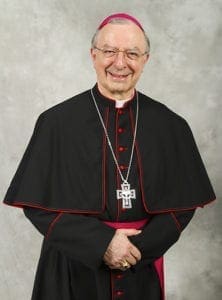Praying the Liturgy of the Hours
By BISHOP JOEL M. KONZEN, S.M. | Published April 19, 2024 | En Español
Jesus, in many instances in the Gospels, instructs his listeners to pray. So, whenever we stop what we are doing to pray or begin our day or end our day with prayer, we are following his earnest directive. For most Christians, the will to pray and the need to pray are lifelong preoccupations. There are many ways to pray, so finding those avenues of prayer that are most suitable, and even trying new ways to pray, bears abundant rewards.

Bishop Joel M. Konzen, S.M.
In addition to a number of prayers that we know by heart or are recited together, the Catholic Church has a body of prayer that is meant for the whole church to use throughout the day. And it is different for each day of the church year, a short collection of psalms and Scripture readings and intercessions designed to be prayed at different times of the day. This prayer is known by several names: Liturgy of the Hours, the Prayer of the Church, or the Divine Office. Priests and deacons refer to it as the breviary, from the book in which these prayers are collected; sometimes it is simply referred to as “the office.” When they receive the sacrament of holy orders, priests and deacons commit to praying these prayers daily. But the prayer is open to all.
We Catholics haven’t always done a good job of publicizing this prayer. One reason is that the Mass takes precedence. The Mass is the one form of worship that is indispensable for us. Many Catholics, though, find that offering the Prayer of the Church is a welcome complement to attendance at Mass or a valuable prayer when one cannot attend Mass. There are simple forms of this prayer in a smaller volume called Christian Prayer, in which morning and evening prayer, in a four-week cycle, is offered. These prayers, along with brief meditation, take about fifteen minutes each.
The full Liturgy of the Hours is comprised of eight separate occasions of prayer each day: Office of Readings, Morning Prayer, Daytime Prayer, Midmorning, Midday, Midafternoon, Evening Prayer, and Night Prayer (Compline). Some are longer, and some are shorter. Most frequently used are Morning and Evening Prayer. Some people find that time in adoration is an opportunity to “make the hours.”
There are also great apps for one’s phone that allow you to pray the complete prayers, or just morning and evening prayers, each day from your phone. There is iBreviary or Laudate or Universalis (in English or Spanish), and if you want to listen to the prayers and accompanying hymn, you can use one called simply Divine Office (in Spanish, Liturgia de las Horas CEE). I like using Divine Office in the car, and others find it great to listen to while walking or traveling.
These prayers are used in private by the clergy and others, but are recommended for praying as a communal liturgy, before or after daily Mass or as a parish evening prayer. As I said earlier, we haven’t been ambitious in seeing that the whole church knows about this universal prayer or has had a chance to become familiar with it. There are parishes, however, in the archdiocese that offer some times for parishioners to pray these prayers together.
When you go to the great cathedrals of the world and you sit for Evensong, the prayer that is chanted is the church’s Evening Prayer. Of course, we are encouraged to use other forms of prayer besides this one that is available for recitation or silent use. But one great benefit of the Liturgy of the Hours is the experience of “praying with the church,” of offering the same prayers throughout the day as are being offered in all places that day. Most important is that we pray, however we choose to do so.